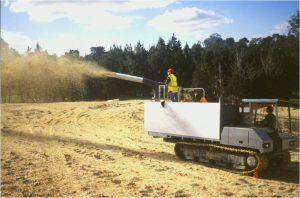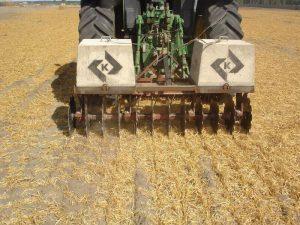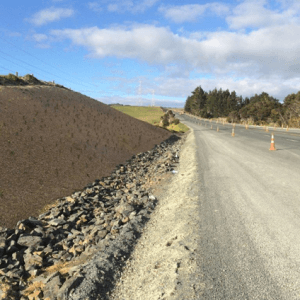Erosion control
Soil and surface stabilisation practicesMulching
What, why, when and issues to look out for
What
Mulching means applying a protective layer of straw or other suitable material to the soil surface.
Straw (wheat or barley) and hay are the most commonly used materials, but mulch can also be bark, wood residue and wood pulp.
Why
Mulching is a rapid stabilisation technique to protect the soil surface from the forces of raindrop impact.
It also conserves moisture, retains warmth, reduces runoff and erosion, prevents soil crusting and promotes the establishment of your vegetation. It will help you establish vegetation successfully at more difficult times of the year.
Mulching for erosion control purposes is usually a short to medium-term treatment. It can be used as a stand-alone surface cover or in conjunction with a seed and fertiliser grassing programme.
When
Mulching is mainly used in the following situations:
- Any time it is important to protect the surface of the soil.
- When you need to achieve an immediate stabilised surface cover and maintain it for the short to medium term (3–5 months). For example, if you need to stabilise an area that will not be worked on for a period of time.
- When you need to avoid soil temperature fluctuations, and want to create a warmer microclimate. This provides appropriate conditions for seed germination and establishment of vegetation at most times of the year.
- To provide rapid and effective protection from wind erosion for flat or gently sloping soil.
-
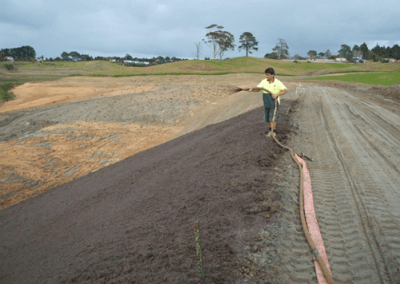
Hydromulch being applied to a slope (Source: Erosion Control Limited).
-
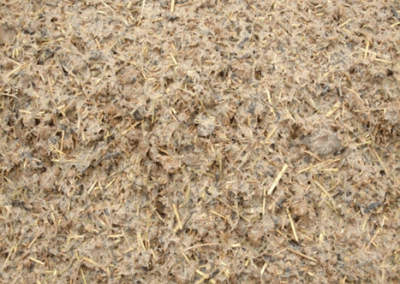
Hydrohay as applied (Source: Erosion Control Limited).
Issues to look out for
The following limitations apply to mulching:
- Mulching large areas needs to be done with specialised equipment, to achieve uniform coverage. Hand mulching can occur on smaller areas.
- Both hay and straw mulch have limited periods of effectiveness. In general, hay will last for 3 months and straw mulch for up to 5 months before becoming part of the soil matrix and no longer providing effective cover.
- There is a risk that mulching can introduce weed species, so it may not be an appropriate method for some sites. Take care that weed infestation of the mulched area does not create a future issue.
- Plan your mulching programme and confirm your contractors well ahead of time.
- Hay or straw mulch can be dislodged by intense rainfall or Canterbury’s typically high winds, so you will need to press or crimp mulch into the soil.
- Mulch is not an appropriate cover in areas of concentrated flow paths or in stream channel systems. Make sure that the mulch doesn’t block flocculant treatment devices or interrupt the operation of decants in ponds.
- Applying hay or straw mulch by blowing may not be practical next to motorways or other high traffic areas and adjoining residential areas.
Design essentials
To stabilise an area, the mulch must completely cover the whole area. Rates for applying the different materials vary, so you need to consult a mulching contractor. The rates are usually as follows:
- Straw or hay mulch must be applied at a rate that completely covers the soil surface, which is usually around 4,000–6,000 kg/ha. Mulch material must be unrotted, relatively free of weeds and not contain any pest plant species. See Environment Canterbury’s list of pest plant species.
- Hydromulch applications must contain at least 80% virgin or recycled wood and be applied according to the manufacturer’s specifications. The rate is 2,200–2,800 kg/ha depending on the slope gradient. The coverage should not exceed slope lengths more than 150 m long.
- Woodchip can be applied at around 10,000–13,000 kg/ha. Bark mulch generally deteriorates slowly but can affect soil nitrogen levels, making nitrogen unavailable to plants. It can also leach saps and tannins and cause a change in pH, so take care when applying wood chip beside watercourses and on steeper slopes.
-
If you have problems keeping the mulch material on site (eg during windy conditions), the mulch will need to be anchored, by:
- Crimping:
- Using a tractor-drawn implement designed to punch and anchor mulch into the top 50 mm of the soil profile. On sloping land, crimp on the contour whenever possible. (Note: Crimping is not suitable on soft soils, and standard agricultural disks used for soil drying are not suitable for crimping).
- Binders or tackifiers:
- These can be applied directly as the mulch is distributed, at an application rate that matches the manufacturer’s specifications for that specific binder.
Construction, operation and maintenance
When constructing and operating use of mulch
- Manage stockpiles of woodchip carefully to reduce the risk of spontaneous combustion. Turn the piles over periodically to reduce the risk of them heating.
- Manage woodchip carefully around watercourses to avoid potential discharge. As woodchip decomposes it can discharge tannins, which can affect water quality.
When maintaining mulch
- To be regarded as stabilised, 100% surface cover must be maintained. You will need to reapply mulch when its integrity and/or surface density has declined.
- Inspect mulch after each rainfall or period of excessively strong wind, and replace any damaged cover.
- Construction equipment can disturb the stabilised areas. You may need to erect temporary barrier fencing and/or signage to restrict movement of equipment and vehicles onto the mulched areas.

